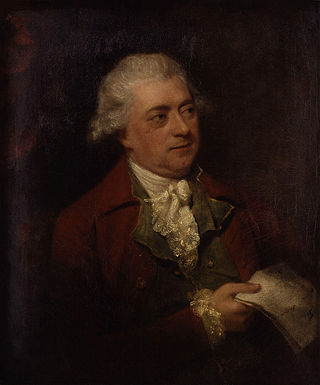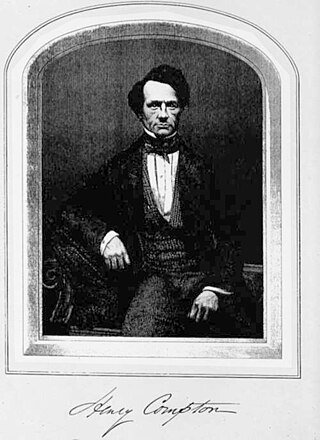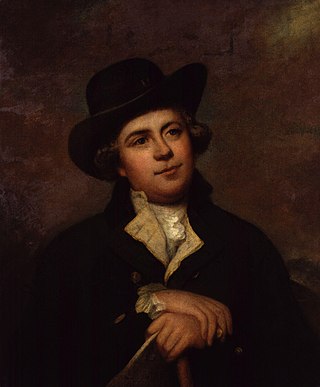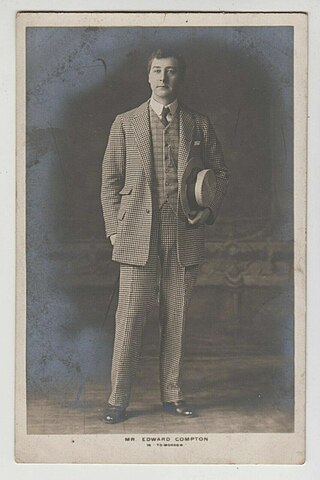
Oliver Goldsmith was a well-known Anglo-Irish novelist, playwright, dramatist and poet, noted for his novel The Vicar of Wakefield (1766), his pastoral poem The Deserted Village (1770), and his plays The Good-Natur'd Man (1768) and She Stoops to Conquer. He is thought by some to have written the classic children's tale The History of Little Goody Two-Shoes (1765).

She Stoops to Conquer is a comedy by Oliver Goldsmith, first performed in London in 1773. The play is a favourite for study by English literature and theatre classes in the English-speaking world. It is one of the few plays from the 18th century to have retained its appeal and is still regularly performed. The play has been adapted into a film several times, including in 1914 and 1923. Initially the play was titled Mistakes of a Night and the events within the play take place in one long night. In 1778, John O'Keeffe wrote a loose sequel, Tony Lumpkin in Town.

John O'Keeffe was an Irish actor and dramatist. He wrote a number of farces, amusing dramatic pieces and librettos for pasticcio operas, many of which had great success. Among these are Tony Lumpkin in Town (1778), Love in a Camp (1786), and Omai (1785), an account of the voyages of the Tahitian explorer Omai, and Wild Oats (1791).

Lorraine Ashbourne is an English actress.

Henry Compton was an English actor best known for his Shakespearean comic roles.

Richard de Pearsall Pearson was an English character actor who appeared in numerous film, television and stage productions over a period of 65 years. He played leading roles in several London West End plays and also supported Maggie Smith, Robert Morley and others in long-running West End stage productions. His many screen appearances included character parts in three Roman Polanski films.
Hardcastle is a surname. Notable people and characters with the surname include:

Lionel "Lal" Brough was a British actor and comedian. After beginning a journalistic career and performing as an amateur, he became a professional actor, performing mostly in Liverpool during the mid-1860s. He established his career in London as a member of the company at the new Queen's Theatre, Long Acre, in 1867, and he soon became known for his roles in Shakespeare, contemporary comedies, and classics, especially as Tony Lumpkin in She Stoops to Conquer.

Leverington is a village and civil parish in the Fenland District of Cambridgeshire, England. The settlement is to the north of Wisbech.

John Quick was a British comic actor.

Tony Lumpkin in Town is a 1778 Irish comedy play by John O'Keeffe. An afterpiece, it was intended as a sequel to the 1773 play She Stoops to Conquer by Oliver Goldsmith. It is centred on the character Tony Lumpkin. It ran successfully at the Theatre Royal, Haymarket in London. The original cast included William Parsons as Tony Lumpkin, Robert Palmer as Doctor Minum and Charles Bannister as Tim Tickle.
Timothy Speyer is a British actor, most notable for his stage work.

She Stoops to Conquer is a 1910 American silent short drama produced by the Thanhouser Company. The film is an adaptation of Oliver Goldsmith's She Stoops to Conquer, possibly adapted by Lloyd Lonergan. The scenario removes a subplot in favor of following Marlow who is sent by his father to court the daughter of an old friend of his. He encounters Tony Lumpkin, who directs him to the Hardcastle mansion, claiming it to be an inn. Hardcastle welcomes Marlow, but Marlow treats his host rudely, unaware of Hardcastle's identity. When the misunderstanding is rectified Marlow refuses to marry Hardcastle's daughter, for he has taken a liking to the maid servant. Caught in the act of making love to the maid by his father, the woman is revealed to be Hardcastle's daughter and all ends well. The film was released on August 19, 1910, but it received mix reviews by critics. The film is presumed lost.
She Stoops to Conquer is a 1914 British silent historical comedy film directed by George Loane Tucker and starring Henry Ainley, Jane Gail and Gregory Scott. It is an adaptation of Oliver Goldsmith's play She Stoops to Conquer.

Mary Bulkley, née Wilford, known professionally as Mrs Bulkley, Miss Bulkley, and later Mrs Barresford, was an English eighteenth-century dancer and comedy stage actress. She performed at various theatres, especially Covent Garden Theatre, the Theatre Royal, Dublin, the Theatre Royal, Edinburgh, the Theatre Royal Haymarket and Shrewsbury Theatre. She performed in all or most of the Shakespearean comedies, and in several tragedies, besides many contemporary comedy plays. She played the part of Hamlet at least twice. She was considered a beauty when young, and her talent was praised. She married George Bulkley and later Captain Ebenezer Barresford, and openly took several lovers. Her early career was successful, but later she was hissed on stage due to her extra-marital affairs, and she died in poverty.

Edward Compton was an actor and actor-manager of the Victorian era who enjoyed considerable success in touring the English provinces with plays by Shakespeare, Sheridan and Goldsmith but who met with failure while trying to break into the West End theatre.

The Angles Theatre is a theatre and historic Georgian playhouse in the market town of Wisbech, Isle of Ely, Cambridgeshire, England. It is among the oldest of Britain's theatres. The current premises consists of the original theatre building and a former library, originally an "infant" school built in 1837, both of which are Grade II listed. The patrons are Sir Derek Jacobi, Jo Brand, Claire Tomalin and Dame Cleo Laine.
William Hamilton was an Irish stage actor of the eighteenth century.

Hubert Osbert Butler Nicholson, known professionally as H. O. Nicholson, was an English character actor of the first half of the 20th century.

William Chapman was a British stage actor active in the late eighteenth century and early nineteenth century. Considerable uncertainly exists about his early biography, but he became an established performer in London's West End at the major theatres Covent Garden, Drury Lane and Haymarket. Considerable crossover may exist with other actors of the era named Chapman.
















